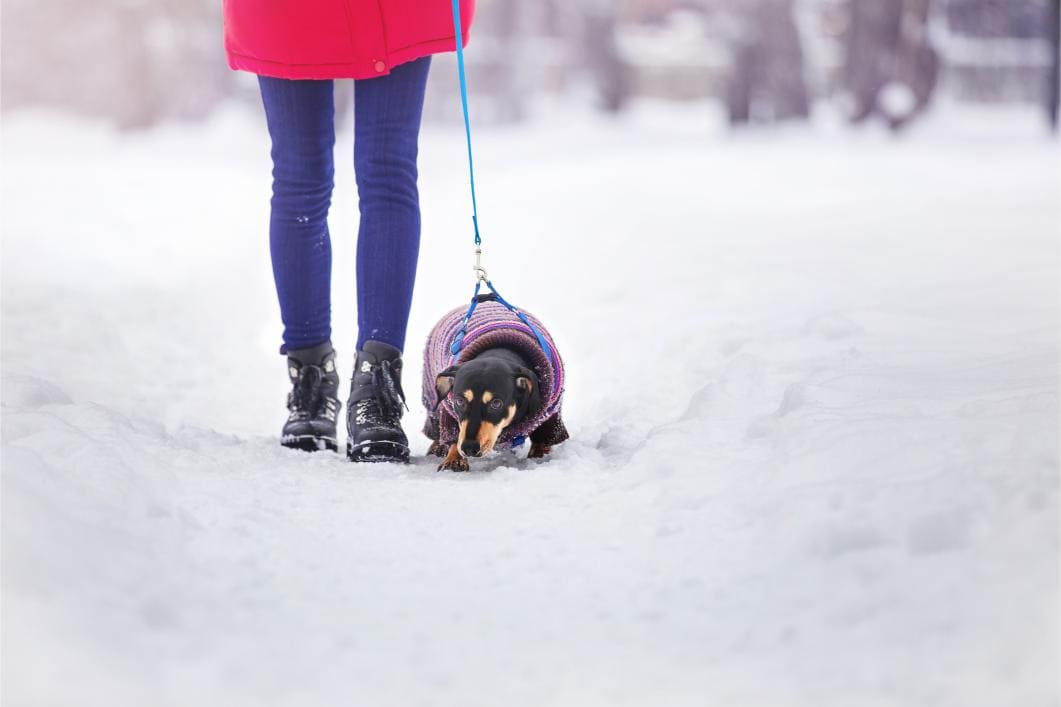Top Winter Dangers for Dogs and Cats

Winter’s arrival brings cozy sweaters, hot chocolate, and peaceful snowfall. But it also brings some seasonal risks for your beloved pets.
As temperatures plummet, we humans know how to bundle up and stay warm, but what about our four-legged family members? At Englishtown Vet MD, we want you to be aware of the winter hazards that pose a real threat to your dogs and cats. Let’s look at some of the common perils of the season for dogs and cats to keep your furry friends safe and healthy.
The Invisible Enemy: Hypothermia in Pets
Many people think that dogs and cats are naturally equipped to handle cold temperatures, but it’s a mistake to believe that a fur coat provides complete protection against the cold. When temperatures drop drastically, hypothermia in pets becomes a genuine concern. Hypothermia occurs when your pet’s body loses heat more quickly than it can produce it, which causes a dangerously low body temperature.
Early symptoms include shivering, weakness, and lethargy. If you notice these signs, warming up your pet immediately is critical. Wrap them in a warm blanket, use a hot water bottle—even your own body heat can help.
Indoor pets are especially vulnerable when they venture outside. They’re not as acclimated to the cold, so even short walks can lead to discomfort or danger. Limit outdoor time and opt for indoor activities. And if you notice any signs of hypothermia, seek immediate veterinary care.
Antifreeze: A Sweet but Deadly Temptation
Winterizing your car often involves the use of antifreeze, but what’s good for your vehicle can be fatal for your pets. Antifreeze has a sweet taste that can attract both dogs and cats, which makes antifreeze and dogs—and indeed all pets—a hazardous mix.
Be cautious when filling your car’s radiator—ensure your pet is safely indoors and that any spills are promptly cleaned up. If ingested, antifreeze can lead to kidney failure within a matter of hours.
Store antifreeze containers well out of reach. If you suspect your pet has ingested even a small amount, don’t delay in getting them to a vet for immediate treatment.
When the Chill Bites Back: Dogs and Frostbite
Pets’ ears, tails, and paws are especially susceptible to frostbite. While you may be excited about playing in the snow with your furry friend, be aware that prolonged exposure to cold can lead to frostbite and cause tissue damage.
Even a brief walk can expose your pets to the risk of frostbite if the weather is cold enough. Booties and coats designed for pets can protect their paws and help them stay warm, but you still need to be cautious about exposure to the cold.
The ears, paws, and tail are particularly susceptible. Signs of frostbite in dogs and cats include:
- Discolored skin (gray, blue, or pale)
- Coldness and swelling of the affected area
- Pain when you touch the affected area
If you notice these symptoms, don’t rub the affected areas or try to warm your pet with direct heat, such as a heating pad or hair dryer, as this can worsen tissue damage. Instead, keep your pet warm with slightly warm (not hot) water or a warm, moist towel. Seek veterinarian help immediately.
As the temperature drops, it’s essential to be mindful of the seasonal risks to your pets. Winter requires extra caution, from hypothermia in pets to the dangers of antifreeze and dogs, as well as the issue of dogs and frostbite.
Dr. Mary Kwacz at Englishtown Vet MD is here to provide guidance and care to keep your pets healthy all year round. To discuss your pet’s winter needs or any other concerns, schedule an appointment or call (732) 387‑7977. Let’s keep this winter a safe, cozy season for your furry family members.
